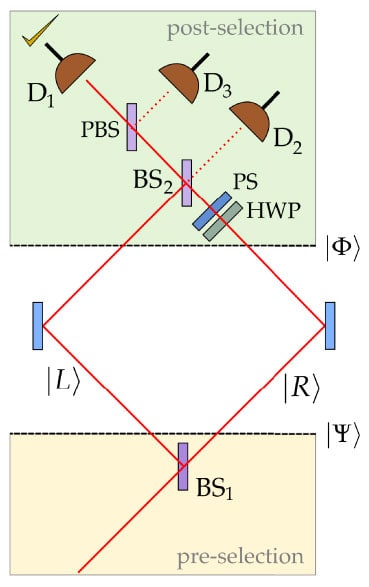
“It’s the most curious thing I ever saw in my life!” Alice thought to herself when she saw a Cheshire cat disappear and leave only its grin behind. It is not only in Wonderland, however, that properties of objects can exist independently of the objects themselves. That is the conclusion of a group of physicists from Israel and the UK, which has shown how the strange laws of quantum mechanics permit a photon to be in one place and its circular polarization in another.
This counterintuitive result was achieved thanks to the quantum-mechanical concept of post-selection. In classical physics, the initial conditions of a set of particles and the rules governing the behaviour of those particles are in principle enough to determine the properties of the particles at any arbitrary point in the future. That is not the case in quantum mechanics, in which a particle’s evolution is inherently probabilistic. So while the results of a measurement carried out on a set of particles will have a known probability distribution, individual results cannot be predicted.
Post-selection, pioneered by Yakir Aharonov of Tel Aviv University, involves preparing a group of particles in some initial state, measuring each of the particles at a certain point in time, and then making a second set of measurements at a slightly later time. The results of the intermediate measurements will, on average, imply certain results for the later measurements but will not determine them. If the group is then split into sub-groups according to these later results, the identity of the members of those various sub-groups is information that can only be obtained after the final measurements, and not before.
Superposition of paths
In the latest work, Aharonov has teamed up with Sandu Popescu of the University of Bristol, Daniel Rohrlich of Ben Gurion University and Paul Skrzypczyk, then at Cambridge University. The group has devised an experiment, which it says can be implemented with current technology, in which individual horizontally polarized photons pass through a beamsplitter and then traverse a series of optical devices before being registered in one of three detectors. When leaving the beamsplitter, each photon is in some kind of superposition of two different paths that it can take to reach the other devices, the two paths representing the two arms of an interferometer (see figure “An optical Cheshire cat”).

The devices are chosen and arranged so that the first of the detectors only clicks when the photon is in a specific superposition state, and it is this state that is post-selected. The researchers then consider what happens to the photon – the Cheshire cat – and its polarization – the grin – in that post-selected state. They find that while any photon detector would reveal the photon to always travel along the left-hand arm, a polarization detector would occasionally measure angular momentum in the right-hand one. “We seem to see what Alice saw,” the researchers write, “a grin without a cat!”
The researchers point out that this analysis falls down because it relies on the two kinds of detector being used at different times, and that if they were to be used simultaneously, the detectors would always show the photon and its polarization together in the same arm. But Aharonov and colleagues argue that they can “regain the paradox” by carrying out what are known as “weak measurements”, which do not provide definitive values of particle parameters but do have the virtue of not completely destroying a particle’s quantum state, as usually happens during the measurement process.
Making weak measurements
The researchers say that weak measurements can be made of the photons’ trajectory by replacing the first detector in their hypothetical experiment with a CCD camera and by placing a sheet of glass in one of the arms. Deflection by the glass – which reveals photons to have travelled down that arm and which would be registered by the camera – is made deliberately much smaller than the width of the photon beam, with the resulting uncertainty then reduced via multiple measurements. Analogously, polarization is measured by placing a suitable optical element in one of the arms and recording a deflection at right angles to that caused by the glass sheet.
The crucial point about this revised set-up, explains the Israeli–UK team, is that it can be used to measure different parameters at the same time. As such, the researchers claim, putting both the glass and the optical element in the right arm of the interferometer would prove that the polarization could exist independently of its photon. Which would mean, the researchers write, that they had “finally found [the] Cheshire cat”.
“Beyond the mainstream”
Having had to wait for a 21 months between posting its proposal on the arXiv preprint server and seeing it published in New Journal of Physics, Popescu acknowledges that his group’s scheme was not well received by all of the referees who reviewed it. “It is beyond the mainstream,” he says. “But quantum mechanics has been around for almost 100 years and people still don’t understand it profoundly. Discovering effects like this, which expose the weirdness of quantum mechanics, may help.”
Popescu says that the Cheshire-cat effect is quite general – that there is nothing in principle to prevent the separation of, say, an electron’s spin and charge, or an atom from its internal energy. Indeed, an alternative to the current experimental proposal would involve cutting off a group of electrons from its own magnetic field. Being a group phenomenon, he points out, this would have the advantage of revealing the Cheshire cat unambiguously at a single instant in time rather than as the average of a series of repeated measurements, but would, he says, require experimental techniques beyond the realm of current technology.
Antonio Di Lorenzo of the Federal University of Uberlandia in Brazil agrees that the experiment proposed by Aharonov and co-workers could be used to find quantum Cheshire cats. But he says they are mistaken in the criterion that they use to identify their quarry. Rather than consider the outputs of the “cat detector” and “smile detector” separately, he argues, they should instead establish the product of these two outputs. A non-zero answer, he says, would reveal the cat.
- Find out much more about weak measurement in “In praise of weakness” by Aephraim Steinberg, Amir Feizpour, Lee Rozema, Dylan Mahler and Alex Hayat



